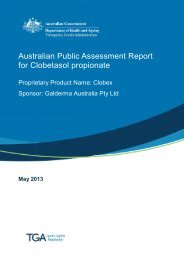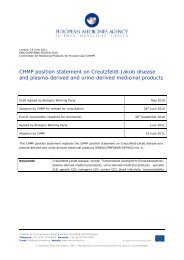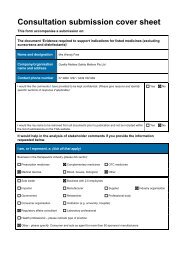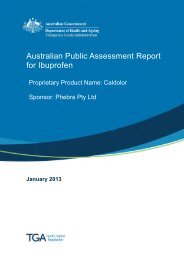AusPAR: Ivabradine - Therapeutic Goods Administration
AusPAR: Ivabradine - Therapeutic Goods Administration
AusPAR: Ivabradine - Therapeutic Goods Administration
You also want an ePaper? Increase the reach of your titles
YUMPU automatically turns print PDFs into web optimized ePapers that Google loves.
<strong>AusPAR</strong> Coralan <strong>Ivabradine</strong> Servier Laboratories (Australia) Pty Ltd PM-2010-03269-3-3<br />
Final 31 October 2012<br />
<strong>Therapeutic</strong> <strong>Goods</strong> <strong>Administration</strong><br />
blocker dose. In addition, although the subgroup analysis in the general patient population<br />
showed effect in favour of ivabradine over placebo in both subgroups of “age < 65 years”<br />
and “age ≥ 65 years”, the relative risk reductions were greater in the subgroup of “age < 65<br />
years” than that of “age ≥ 65 years although interaction tests showed that the differences<br />
were not statistically significant (Table 11). Subgroup analysis in RSBBdose population of the<br />
endpoint of all-cause mortality also showed that there was no effect in favour of<br />
ivabradine compared to placebo. All these suggest that the beneficial effect of ivabradine<br />
appeared to be less in CHF patients ≥ 65 years old. Although analysis in subgroup of age ≥<br />
75 years in the RS population showed relative risk reduction in favour of ivabradine in the<br />
primary composite endpoint and the component endpoints of cardiovascular death and<br />
hospitalisation for worsening heart failure, of 11%, 29%, and 8% respectively, statistical<br />
significance was not done or presented and the sample size was small (n=722) and thus<br />
these results did not help in characterising efficacy in the elderly age group.<br />
Table 11. Relative risk reductions in subgroups of “age < 65 years” and “age ≥ 65 years”, RS<br />
population<br />
Primary composite<br />
endpoint<br />
Cardiovascular<br />
death<br />
Hospitalisation for<br />
worsening heart<br />
failure<br />
RRR: Relative risk reductions<br />
Relative risk reductions (in<br />
favour of ivabradine over<br />
placebo)<br />
“age < 65<br />
years”<br />
(n=4031)<br />
“age ≥ 65<br />
years”<br />
(n=2474)<br />
24% 11% P=0.0993<br />
12% 7% P=0.6514<br />
33% 17% P=0.0794<br />
P value (statistical<br />
significance of difference in<br />
RRR between subgroups)<br />
With regards to improvement in symptoms, a statistically significant higher proportion of<br />
patients in the ivabradine group compared with those in the placebo group improved by<br />
≥1 NYHA class relative to baseline, had an improved Patient Reported Global Assessment<br />
and an improved Physician Reported Global Assessment. However, the differences<br />
between treatment groups were small (27.6% versus 24%, 72% versus 68%, and 61%<br />
versus 57%, respectively). In addition, these assessments were done by study<br />
investigators or patients who were not blinded to the heart rates or blinding could not be<br />
assured, leading to the possibility of bias.<br />
Comment: The reply from the sponsor to EMA regarding its question on the issue of<br />
blinding in the context of the differential effects of ivabradine and placebo on HR<br />
was noted by the clinical evaluator. The sponsor has responded that “it is unlikely<br />
that knowing the change in heart rate could have jeopardized the blind of the study<br />
as the mean significant reduction in heart rate observed in the overall population of<br />
patients treated with ivabradine compared to placebo does not apply consistently at<br />
an individual level”. The sponsor presented data which showed that more than 30%<br />
of the patients in the placebo group had a heart rate reduction greater than 10 bpm<br />
at Day 28 and at 1 year, while conversely, in the ivabradine group 14% and 19% of<br />
patients had a heart rate reduction of less than 5 bpm at Day 28 and at 1 year,<br />
Page 34 of 101
















